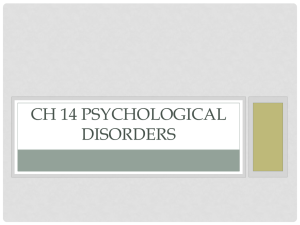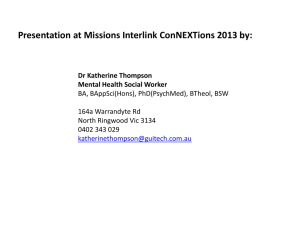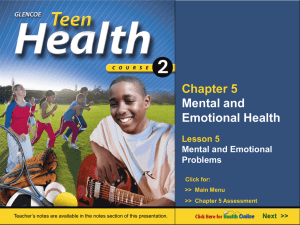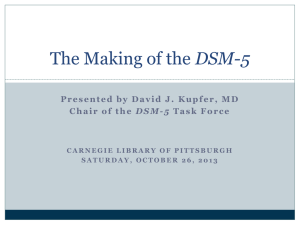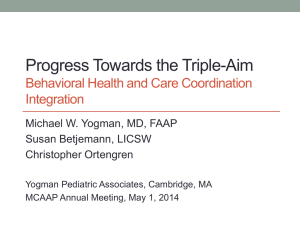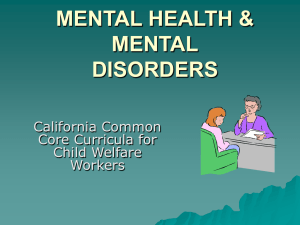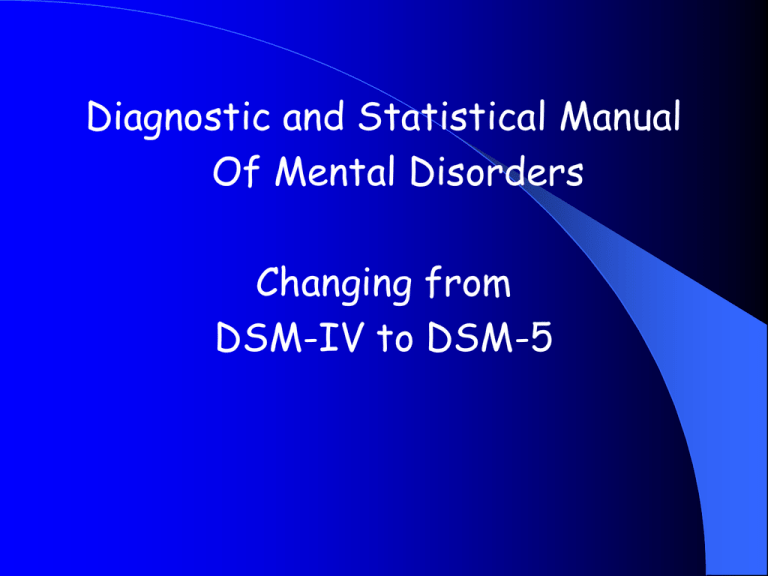
Diagnostic and Statistical Manual
Of Mental Disorders
Changing from
DSM-IV to DSM-5
Steve Franklin
Shelly Justison
Kathleen McMullan
(Thanks to Dr. Donald W. Black
Author of DSM-5 Guidebook )
MSCSW
September 7, 2013
Disclosures
Steve Franklin received free copy for
participating in field trials.
Director of the National Institute of Mental Health (NIMH)
Thomas Insel
NIMH Research Domain Criteria (RDoC),
a possible future replacement diagnostic
tool incorporates genetics, imaging, and
other data into a new classification system
and as "a first step towards precision
medicine."
"what may be realistically feasible today
for practitioners is no longer sufficient for
researchers."
Director of the National Institute of Mental Health (NIMH)
Thomas Insel
BUT
[DSM & ICD (International Classification of Diseases)]
“remain the contemporary consensus
standard to how mental disorders are
diagnosed and treated," …
"DSM-5 and RDoC represent complementary,
not competing, frameworks for this goal."
DSM-5
22 Chapters
DSM-IV
17 Chapters
DSM-I (1952)
132 pages
Mental disorders as “reactions”
Definitions were simple,
brief paragraphs
with prototypical descriptions
DSM-II (1968)
134 pages
“Reaction” terminology dropped
Users encouraged to record
multiple psychiatric diagnoses
(in order of importance)
and associated physical conditions
Coincided with ICD-8
(first time ICD included mental disorders)
DSM-III (1980)
494 pp
Descriptive and neutral
“atheoretical”) regarding etiology.
Coincided with ICD-9.
Multiaxial classification system.
Goal to introduce reliablilty.
DSM-IV (1994)
886 pp
Inclusion of a clinical significance criterion
New disorders introduced
(e.g., Acute Stress Disorder, PTSD
Bipolar II Disorder, Asperger’s Disorder),
others deleted
(e.g., Cluttering,
Passive-Aggressive Personality Disorder).
DSM-5 (2013)
947 pp
“5” instead of “V”
Anticipates change
e.g. DSM 5.1 … 5.2 …
Development started with 1999 meeting
Task force recruited in 2006
Work Groups to consider
dimensional measures.
e.g. severity scales
or cross-cutting across disorders
culture/gender issues.
Field trials
Organized to assess reliability
2246 patients interviewed (86% twice)
Based on DSM-5 criteria.
Interviews were conducted by
279 clinicians in various disciplines
Scientific reviews written.
Over 1000 members/consultants involved.
Aimed (with limited success)
to be transformative
3 Internet postings of changes for review
A Scientific Review Committee reviewed
evidence for validating revisions.
Peer Review process with hundreds of experts
to consider clinical/public health
risks and benefits of proposed changes.
Approved
APA Assembly (November 2012)
Board of Trustees (December 2012)
CHANGES
Chapters reorganized
reflects developmental lifespan
between and within chapters
CHANGES
New categories:
Obsessive-Compulsive and Related Disorders
Trauma- and Stressor-Related Disorders
Transformed:
Neurodevelopmental Disorders
(Infancy, adolescence, childhood)
Somatic Symptom and Related Disorders
Changes
Discontinued 5-Axis system
[No more denials for “Axis 2” or GAF?]
NOS replaced by "Other Specified”
or “Unspecified”
“Another Medical Condition" instead
of “General Medical Condition”
Changes
Axis 4 gone
might use V & (Z in ICD 10) codes
Axis 5 gone;
might use WHODAS from Section III
List multiple diagnoses
in order of attention or concern
New Disorders
Social (Pragmatic) Communication Disorder
Disruptive Mood Dysregulation Disorder
Premenstrual Dysphoric Disorder
Hoarding Disorder
Excoriation (Skin‐Picking) Disorder
New Disorders
Disinhibited Social Engagement Disorder
(split from Reactive Attachment Disorder)
Binge Eating Disorder
Central Sleep Apnea
Sleep-Related Hypoventilation
Rapid Eye Movement Sleep Behavior Disorder
New Disorders
Restless Legs Syndrome
Caffeine Withdrawal
Cannabis Withdrawal
Major Neurocognitive Disorder with Lewy Body Disease
(Dementia Due to Other Medical Conditions)
Mild Neurocognitive Disorder
ELIMINATED
Sexual Aversion Disorder
Polysubstance-Related Disorder
Combined
Language Disorder
(Expressive Language Disorder
& Mixed Receptive Expressive Language Disorder)
Autism Spectrum Disorder
(Autistic Disorder,
Asperger’s Disorder,
Childhood Disintegrative Disorder,
Rett’s disorder
Pervasive Developmental Disorder-NOS)
Combined
Specific Learning Disorder
(Reading Disorder,
Math Disorder,
Disorder of Written Expression)
Delusional Disorder
(Shared Psychotic Disorder,
Delusional Disorder)
Combined
Panic Disorder
(Panic Disorder Without Agoraphobia
Panic Disorder With Agoraphobia)
Dissociative Amnesia
(Dissociative Fugue
Dissociative Amnesia)
Combined
Somatic Symptom Disorder
(Somatization Disorder
Undifferentiated Somatoform Disorder
Pain Disorder)
Insomnia Disorder
(Primary Insomnia
Insomnia Related to Another Mental Disorder)
Combined
Hypersomnolence Disorder
(Primary Hypersomnia
Hypersomnia Related to Another Mental Disorder)
Non-Rapid Eye Movement Sleep
Arousal Disorders
(Sleepwalking Disorder
Sleep Terror Disorder)
Combined
Genito‐Pelvic Pain/Penetration Disorder
(Vaginismus
Dyspareunia)
Alcohol Use Disorder
(Alcohol Abuse
Alcohol Dependence)
Cannabis Use Disorder
(Cannabis Abuse
Cannabis Dependence)
Combined
Phencyclidine Use Disorder (Phencyclidine
Abuse
Phencyclidine Dependence)
Other Hallucinogen Use Disorder
(Hallucinogen Abuse
Hallucinogen Dependence)
Inhalant Use Disorder
(Inhalant Abuse
Inhalant Dependence)
Combined
Opioid Use Disorder
(Opioid Abuse
Opioid Dependence)
Sedative, Hypnotic, or Anxiolytic Use Disorder
(Sedative, Hypnotic Anxiolytic Abuse
Sedative, Hypnotic, or Anxiolytic Dependence)
Stimulant Use Disorder
(Amphetamine Abuse
Amphetamine Dependence;
Cocaine Abuse
Cocaine Dependence)
Combined
Stimulant Intoxication
(Amphetamine Intoxication
Cocaine Intoxication)
Stimulant Withdrawal
(Amphetamine Withdrawal
Cocaine Withdrawal)
Substance/Medication-Induced Disorders
(aggregated categories:
Mood , Anxiety ,and Neurocognitive )
NOS DSM IV = 41
Other/Unspecified DSM-5 =65
(To match ICD-10)
When To Use DSM-5?
CMS actually uses ICD-9, “crosswalk” now
DSM5 coding includes ICD-9 and ICD- 10
ICD-10 conversion October 1, 2014)
Insurance/other will adapt to
elimination of 5-Axis system
(CIGNA: Requires DSM 5 on Jan. 1, 2014)
Section I
Orientation
Historical back ground
Development of DSM-5
How to use it
Section II
Diagnostic Criteria and codes
“Medication-induced Movement Disorders”
“Other Conditions That May be
a Focus of Clinical Attention.”
Section III
Emerging Measures and Models
Assessment measures
http://www.psychiatry.org/practice/dsm/dsm5/online-assessment-measures
Cultural formulation
Alternative DSM-5 model for
personality disorders
“Criteria Sets for Conditions
for Further Study”
Appendix
Highlights of changes
from DSM-IV to DSM-5
Glossary of technical terms
Glossary of cultural terms
Alpha & numeric listings of
diagnoses and codes
List of advisors and contributors
STRUCTURE FOR EACH DIAGNOSIS
Diagnositic Criteria
Subtypes and/or specifiers
Severity
Codes and recording procedures
Explanatory text (new or expanded)
STRUCTURE FOR EACH DIAGNOSIS
Diagnostic and associated features
Prevalence
Development and course
Risk and prognosis
Culture- and gender-related factors
STRUCTURE FOR EACH DIAGNOSIS
Diagnostic and associated features
Diagnostic markers
Functional consequences
Differential diagnosis
Comorbidity
SECTION 2: CHAPTERS
Neurodevelopmental disorders
Schizophrenia spectrum and
other psychotic disorders
Bipolar and related disorders
Depressive disorders
SECTION 2: CHAPTERS
Anxiety disorders
Obsessive-compulsive and related disorders
Trauma- and stressor-related disorders
Dissociative disorders
Somatic symptom and related disorders
Feeding and eating disorders
SECTION 2: CHAPTERS
Elimination disorders
Sleep-wake disorders
Sexual dysfunctions
Gender dysphoria
Disruptive, impulse-control,
and conduct disorders
Substance-related and addictive disorders
SECTION 2: CHAPTERS
Neurocognitive disorders
Personality disorders
Paraphilic disorders
Other Mental Disorders
Medication-induced movement disorders
and other adverse effects of medication
Other conditions that may be a focus
of clinical attention (V/Z Codes)
Neurodevelopmental Disorders
Autistic Spectrum Disorder
Replaces
Autistic disorder
Asperger’s disorder
Childhood disintegrative disorder
Pervasive developmental disorder NOS
Rationale:
Poor reliability in application of DSM criteria
Neurodevelopmental Disorders
Autistic Spectrum Disorder
Deficits in social communication/interaction
Restrictive/Repetitive patterns of
behavior, interests, activities
Table for 3 levels of severity
Neurodevelopmental Disorders
Autistic Spectrum Disorder
Specifiers can describe variants
e.g., ASD
Without intellectual impairment
without structural language
impairment
(Instead of Asperger’s)
Neurodevelopmental Disorders
Intellectual Disability
Term fixed by federal statute
(ICD-11: intellectual developmental disorder).
“Deficits… confirmed by assessment
…testing..” instead of just IQ #.
Greater emphasis on adaptive functioning deficits
Same severity specifiers:
mild, moderate, severe, or profound
Descriptive table for specifiers
Under 5 years: “Global Developmental Delay”
Neurodevelopmental Disorders
Intellectual Disability
Intellectual Disability (Intellectual Developmental Disorder)
ERROR
319 (70) Mild
319 (71) Moderate
319 (72) Severe
319 (73) Profound
CORRECTION
317 (70) Mild
318.0 (71) Moderate
318.1 (72) Severe
318.2 (73) Profound
Neurodevelopmental Disorders
Communication Disorders
( formerly phonological disorder and stuttering)
Language Disorder,
Speech Sound disorder,
Childhood-Onset Fluency Disorder (stuttering)
Social (pragmatic) Communication Disorder-new
Impaired Social Nonverbal communication
“not better explained by ASD, IDD, GDD”
Neurodevelopmental Disorders
Communication Disorders
Language Disorder
ERROR
315.39 (F80.9)
CORRECTION
315.32 (F80.2)
Neurodevelopmental Disorders
ADHD
Same criteria checklist, but expanded to
include examples
Age of onset “before 12 years” (was 7)
(Studies show emergence after greater
challenge in school)
Only 5-Symptom threshold for adults (17+)
based on longitudinal studies
Expect minimal increase in the prevalence
of adult ADHD.
Neurodevelopmental Disorders
SPECIFIC LEARNING DISORDER
Umbrella of criteria
Specifiers for math, reading, written
Neurodevelopmental Disorders
MOTOR DISORDERS
Developmental Coordination Disorder
Stereotypic Movement Disorder
Neurodevelopmental Disorders
Tic Disorders
Tourette’s,
Persistent (Chronic) Motor or Vocal TD
Provisional TD (previously“Transient”)
Other
Unspecified
Neurodevelopmental Disorders
OTHER NEURODEVELOPMENTAL DISORDERS
Other ND
Unspecified ND
Shelly
Schizophrenia Spectrum and Other Psychotic
Disorders:
Schizophrenia:
The elimination of bizarre delusions.
Rationale: Poor reliability in distinguishing bizarre vs.
non-bizarre delusions.
At least 1 of 2 required sx to meet Criterion A must be
delusions, hallucinations, or disorganized speech.
Rationale: Improve reliability and prevent individuals w/
only negative sx and catatonia from being dx w/
Schizophrenia.
Schizophrenia Spectrum and Other Psychotic
Disorders
Cont…
Schizophrenia cont…
The DSM-IV subtypes of schizophrenia have been
eliminated.
Instead a dimensional approach to rating severity for the
core symptoms of schizophrenia is included in DSM-5
Section III.
Rationale: Limited diagnostic stability, low reliability, and
poor validity.
Schizophrenia Spectrum and Other Psychotic
Disorders
Cont…
Schizoaffective Disorder:
The primary change to schizoaffective disorder is that a
major mood episode be present for the majority of the
disorders total duration after criterion A has been met.
Rationale: To improve reliability, diagnostic stability, and
validity of this disorder.
Schizophrenia Spectrum and Other Psychotic
Disorders
Cont…
Delusional Disorder:
Criterion A no longer has the requirement that the
delusions be non-bizarre. A specifier is now included for
bizarre type delusions.
Delusional disorder is no longer separated from shared
delusional disorder.
Catatonia:
The criteria for catatonia is now uniform for all contexts
and requires 3 sx from a total of 12.
Steve
Bipolar and Related Disorders
Manic/Hypomanic
Add to Criterion A:
“and abnormally and persistently
increased goal-directed activity
or energy.”
Bipolar and Related Disorders
No more “Mixed Episode”
(was: full Manic + MDD nearly every
day/ 1 week)
Now a specifier:
“with mixed features”
Hypomanic Manic + 3/6 MDD symptoms
or MDD + 3/7 Manic symptoms
Bipolar and Related Disorders
Bipolar I Disorder, Current or most recent
episode hypomanic, In partial remission
ERROR
296.45 (F31.73)
CORRECTION
296.45 (F31.71)
Bipolar and Related Disorders
Bipolar I Disorder, Current or most recent
episode hypomanic, In full remission
ERROR
296.46 (F31.74)
CORRECTION
296.46 (F31.72)
DEPRESSIVE DISORDERS
DISRUPTIVE MOOD DISREGULATION
Severe, age inappropriate temper
outbursts 3+x weekly
Daily irritable, angry mood 12 months, not
asymptomatic 3 months; 2/3 settings
Dx between 6-18 years; onset <10 years
Not meeting criteria for manic/hypomanic
for full day or ODD or IED
(Purpose: Prevent Manic dx & subsequent
antipsychotic medication)
DEPRESSIVE DISORDERS
MAJOR DEPRESSIVE DISORDER
“Bereavement exclusion” removed
Includes “note”: significant loss may
result in some Criterion A symptoms.
MDD may also be considered in
context of clinical judgment, history,
and cultural norms.
DEPRESSIVE DISORDERS
Persistent Depressive Disorder (Dysthymia)
MDD may be present 2 years (previously
excluded)
Premenstrual Dysphoric Disorder
5 of4+7 symptoms appear in final week
before onset of most menses, then improve
(lability, irritability, anxiety, depressive,
etc. )
DEPRESSIVE DISORDERS
SUBSTANCE/MEDICATION-INDUCED DEPRESSIVE DISORDER
Removed Criterion A2:elevated, expansive or irritable mood
OTHER SPECIFIED DEPRESSIVE DISORDER
Lists a few examples
UNSPECIFIED DEPRESSIVE DISORDER
e.g. insufficient information
SPECIFIERS
With Anxious distress
PostPartum onset now peripartum onset
(includes during/following pregnancy)
Kathleen
Anxiety Disorders
“The anxiety must be out of proportion to the
actual danger or threat in the situation”
This chapter no longer includes OCD and PTSD
DSM 5 creates new chapters for OCD and PTSD
Chapter is arranged developmentally.
Sequenced by age of onset
Now includes Separation Anxiety and
Selective Mutism
Selective Mutism
ERROR
312.23 (F94.0)
CORRECTION
313.23 (F94.0)
Anxiety Disorders
Agoraphobia ,
Specific Phobia, and
Social Anxiety Disorder
Changes in criteria :
Clients over 18 do not have to recognize that
their anxiety is excessive or unreasonable
Duration of 6 months or longer is required
for all ages
Anxiety Disorders
Panic Attacks and Agoraphobia are “unlinked” in
DSM- 5
DSM- IV terminology describing different types of
Panic Attacks replaced in DSM-5 with the terms
“expected” or “unexpected” panic attack
Social Anxiety Disorder :
“Generalized” specifier in DSM-IV has been
deleted
Replaced with “performance only” specifier
Obsessive Compulsive and Related
Disorders
New chapter created for DSM 5
Rationale for this chapter grouping:
Increasing evidence that these disorders are
related to each other
OCD and Related Disorder Chapter
New disorders in chapter :
Hoarding disorder
Excoriation (skin picking) disorder
Substance /Medication–induced OCD
OCD due to another medical condition
Trichotillomania, now termed trichotillomania
disorder (hair pulling), moved to OCD chapter;
No longer classified as an impulse control disorder.
Trichotillomania (Hair-Pulling Disorder)
ERROR
312.39 (F63.2)
CORRECTION
312.39 (F63.3)
OCD and Related Disorders
Specifiers listed for each OCD disorder
-Specifier
“with poor insight” in DSM- IV has
been expanded in DSM- 5
-New Specifiers are
- “with good or fair insight”
- “with poor insight”
- “with absent insight/delusional beliefs”
Intent of these specifiers is to improve
differential diagnoses
OCD and Related Disorders
Body Dysmorphic Disorder
A criterion added: “Preoccupation with one or more
perceived defects or flaws in physical appearance that are
not observable or appear slight to others”
Hoarding Disorder added to DSM-5
Due to evidence that it is not a variant of OCD;
Evidence that it is a separate diagnosis
Excoriation Disorder added to DSM-5
Based on strong evidence of diagnostic validity and
clinical utility
Other Specified and Unspecified ObsessiveCompulsive and Related Disorders
DSM-5 includes conditions in this chapter such as
Body-focused repetitive behavior disorder
- other than excoriation and trichotillomania
i.e. nail biting, lip chewing
Obsessional jealousy
Trauma- and Stressor-Related Disorders
New chapter in DSM-5 brings together anxiety disorders
that are preceded by a distressing or traumatic event
Reactive Attachment Disorder
Disinhibited Social Engagement Disorder
(new)
PTSD (includes PTSD for children
6 years and younger)
Acute Stress Disorder
Adjustment Disorders
Trauma- and Stressor-Related Disorders
Disinhibited Social Engagement Disorder
“The essential feature of disorder is a pattern of
behavior that involves culturally inappropriate,
overly familiar behavior with relative strangers.
This behavior violates the social boundaries of the
culture.” DSM-5, p. 269
Trauma- and Stressor-Related Disorders
Acute Stress Disorder
-Stressor criterion in DSM -5 is changed
-Criterion requires being explicit whether
qualifying traumatic events were experienced
directly, witnessed, or experienced indirectly.
-DSM-IV Criterion A2 regarding reaction to the
event- “the person’s response involved intense fear,
helplessness, or horror” –
has been eliminated
Trauma- and Stressor-Related Disorders
Adjustment Disorders -DSM-5
Adjustment Disorders are redefined as an array of
stress-response syndromes occurring after
exposure to a distressing event.
Adjustment Disorder subtypes are unchanged
- with depressed mood
- with anxiety
- with disturbance of conduct
Trauma- and Stressor-Related Disorders
Changes in PTSD Criteria
Four symptom clusters, rather than three
-Re-experiencing
-Avoidance
-Persistent negative alterations in
mood and cognition
-Arousal: describes behavioral symptoms
Trauma- and Stressor-Related Disorders
Changes in PTSD Criteria
DSM-5 more clearly defines what constitutes a
traumatic event
Sexual assault is specifically included
Recurring exposure, that could apply to first
responders
Trauma- and Stressor-Related Disorders
Changes in PTSD Criteria
Recognition of PTSD in Young children
Developmentally sensitive:
Criteria have been modified for children age
6 and younger
Thresholds – number of symptoms in each
cluster - have been lowered
Dissociative Disorders
Derealization has been added to the name and
symptom structure of depersonalization disorder
Depersonalization/Derealization Disorder
Criteria A. The presence of persistent experiences
of either depersonalization or derealization or both
Dissociative Disorders
Depersonalization: Experiences of unreality,
detachment, or being an outside observer with
respect to one’s thoughts, feelings, body
Derealization: Experiences of unreality or
detachment with respect to one’s surroundings
Dissociative fugue is now a specifier of
Dissociative Amnesia and not a separate disorder
Dissociative Identity Disorder
Changes in Criterion A
Expanded - includes certain possession-form
phenomena and neurological symptoms
specifically states that transitions in identity
may be observable by others or self-reported
Changes in Criterion B
Persons with DID may have recurrent gaps in
recall for everyday events, not just for
traumatic experiences.
Shelly
Somatic Symptom and Related Disorders:
Somatoform disorders are now referred to as somatic
symptoms & related disorders in the DSM-5 and are
reduced in number and subcategories to avoid problematic
overlap.
Somatization disorder, hypochondrias, pain disorder, and
undifferentiated somatoform disorder have been removed.
Somatic Symptom and Related Disorders:
Cont…
Somatic Symptom Disorder:
Individuals previously dx w/ somatization disorder will
usually have sx that meet DSM-5 criteria for somatic sx
disorder but only if they have maladaptive thoughts,
feelings, and behaviors in addition to their somatic sx.
Somatization disorder and undifferentiated somatoform
disorder have been merged in DSM-5 under somatic sx
disorder.
Somatic Symptom and Related Disorders:
Cont…
Illness Anxiety Disorder:
Individuals previously dx w/ hypchondriasis who have
high health anxiety but no somatic sx would receive this
DSM-5 dx.
Conversion Disorder:
Modified to emphasize the importance of the neurological
exam and recognizes that relevant psychological factors
may not be present at the time of dx.
Somatic Symptom and Related Disorders:
Cont…
Psychological Factors Affecting Other Medical Conditions
D.O.
New mental disorder in DSM-5 (formerly in DSM-IV
“other conditions that may be a focus of clinical attention”.
Feeding and Eating Disorders:
DSM IV-TR chapter “Disorder Usually First Diagnosed in
Infancy Childhood, or Adolescence” has been eliminated.
Therefore this chapter includes several disorders from
DSM-IV “Feeding and Eating Disorders of Infancy or
Early Childhood”.
Feeding and Eating Disorders:
Cont…
Pica and Rumination Disorder:
Criteria has been revised to allow diagnosis for individuals
of all ages.
Avoidant/Restrictive Food Intake Disorder:
Previously feeding disorders of infancy or early childhood.
Criteria is significantly expanded making it a broader
category to capture a wider range of clinical presentations.
Feeding and Eating Disorders:
Cont…
Anorexia Nervosa:
The requirement for amenorrhea has been eliminated.
Clarity and guidance re: how to judge if an individual is at
“significantly low weight” has been added.
Criterion B has been expanded to include not only “overtly
expressed fear of weight gain” but also “persistent
behavior that interferes w/ weight gain”.
Feeding and Eating Disorders:
Cont…
Bulimia Nervosa :
The only change is the reduction in the required minimum
average frequency of binge eating & inappropriate
compensatory behavior frequency from twice to once
weekly for 3 months.
Feeding and Eating Disorders:
Cont…
Binge Eating Disorder:
Elevated to main body of manual from appendix B in
DSM-IV.
The only change is the minimum average frequency of
binge eating required for diagnosis is once weekly over the
last 3 months (identical to frequency criterion for bulimia
nervosa).
Elimination Disorders:
No significant changes have been made to elimination
disorders.
The disorders in this chapter (enuresis & encopresis) were
previously under “Disorders Usually First Diagnosed in
Infancy, Childhood, or Adolescence” in DSM-IV and are
now independent classifications in DSM-5.
Sleep-Wake Disorders:
Sleep disorder related to another mental disorder and sleep
disorder related to a general medical condition have been
removed.
Insomnia Disorder:
Previously named primary insomnia.
Rationale: to avoid the differentiation between primary &
secondary insomnia.
Insomnia Disorder
ERROR
780.52 (G47.00)
CORRECTION
307.42 (F51.01)
Sleep-Wake Disorders:
Cont…
Narcolepsy:
Is now distinguished from other forms of
hypersomnolence.
Breathing-Related Sleep Disorders:
• Now divided into 3 distinct disorders: obstructive sleep
apnea hypopnea; central sleep apnea; and sleep related
hypoventilation.
Rationale: reflects the growing understanding of
pathophysiology in these disorders.
Hypersomnolence Disorder
ERROR
780.54 (G47.10)
CORRECTION
307.44 (F51.11)
Sleep-Wake Disorders:
Cont…
Circadian Rhythm Sleep-Wake Disorders:
Subtypes expanded to include: advanced sleep phase
syndrome; irregular sleep-wake type; and non-24 hr sleep
wake type.
* Jet lag has been removed.
Rapid Eye Movement Sleep Behavior Disorder
Restless Legs Syndrome
Both are now independent disorders.
Kathleen
Sexual Dysfunctions
“a group of disorders that are characterized by clinically
significant disturbance in a person’s ability to respond
sexually”
In DSM -5 gender-specific sexual dysfunctions
have been added
For purpose of diagnostic precision
-Criteria require a minimum duration
of six months
-Criteria for severity are more precisely defined
as mild, moderate, or severe.
Gender Dysphoria
New diagnostic class in DSM-5
Reflects change in definition, emphasizes “gender
incongruence” rather than cross-gender
identification.
In DSM-IV, three disparate diagnostic classes
grouped in one chapter, “Sexual and Gender
Identity Disorders”
Gender Identity Disorder is neither a sexual
dysfunction nor a paraphilia.
Gender Dysphoria
Is considered a multi-category concept, not a
dichotomy
Separate criteria sets are provided for gender
dysphoria in children, and in adolescents and
adults
Terminology changes include:
-“the other sex” is replaced by “some
alternative gender”
-“gender” is used instead of “sex”
Steve
Disruptive, Impulse-Control, and Conduct Disorders
More detailed
Disruptive, Impulse-Control, and Conduct Disorders
Oppositional Defiant Disorder
Criteria exhibited “with at least one
individual who is not a sibling”
“Spiteful or vindictive twice in 6
months”
Severity: Mild, moderate, severe
<5years most days for 6 months;
>5 years, weekly
Disruptive, Impulse-Control, and Conduct Disorders
Conduct Disorder
Adds specifier “With limited prosocial emotions”
Persistently in 12 months (2 of 4)
Lack of Remorse/ guilt
Callous—lack of empathy
Unconcerned about performance
Shallow or deficient affect
Conduct Disorder, Adolescent Onset Type
ERROR
312.32 (F91.2)
CORRECTION
312.82 (F91.2)
Disruptive, Impulse-Control, and Conduct Disorders
Intermittent Explosive Disorder
Verbal aggression 2x weekly for 3 months
Destruction or assault: 3x in 12 months
6 years +
Not premeditated
Disruptive, Impulse-Control, and Conduct Disorders
AntiSocial Personality Disorder
(criteria in PD chapter) “Dual coded”
Pyromania
Kleptomania
Other DICCD
Unspecified DICCD
Kleptomania
ERROR
312.32 (F63.3)
CORRECTION
312.32 (F63.2)
Shelly
Substance-Related and Addictive Disorders:
DSM-5 consolidates substance abuse and dependence into one
disorder:
substance use disorder accompanied by criteria for: intoxication,
withdrawal, substance-induced disorders, and unspecified related
disorders.
Criteria are nearly identical to DSM-IV w/ exception of:
-Recurrent substance-related legal problems criterion has been deleted
from DSM-5.
-And new criterion: craving, or a strong desire or urge to use a
substance added.
The threshold is set at 2 or more criteria vs. 1 or more for abuse and 3
or more for dependence in the DSM-IV.
Substance-Related and Addictive Disorders:
Cont…
New disorders in substance-related & addictive disorders
chapter of DSM-5:
Gambling Disorder (non-substance related disorder)
Cannabis Withdrawal
Caffeine Withdrawal
* The dx of polysubstance dependence has been eliminated.
Substance-Related and Addictive Disorders:
Cont…
Specifiers:
In DSM-5 severity for substance use disorders is based on
the number of criteria endorsed:
-mild= 2-3 criteria
-moderate = 4-5 criteria
-Severe= 6 or more criteria
The DSM-IV specifier for psychological subtype has been
eliminated.
Substance-Related and Addictive Disorders:
Cont…
In DSM-5 early remission is defined as at least 3 but less
then 12 months without substance use disorder criteria
(except craving).
Sustained remission is defined as at least 12 months
without criteria (except craving).
New specifiers include:
-in a controlled environment
-on maintenance therapy
Neurocognitive Disorders:
Dementia and amnestic disorder are now included under
neurocognitive disorder (NCD).
Rationale: dementia has been associated w/ the older
population whereas NCD will capture etiologies occurring
in younger adults as well.
The term dementia is not excluded from use in etiological
subtypes.
Neurocognitive Disorders:
Cont…
DSM-5 now recognizes a less severe level of cognitive
impairment, mild NCD, allowing a dx of a less disabling
syndrome that may be a focus of concern and treatment.
Diagnostic criteria are provided for both mild NCD and
major NCD, followed by diagnostic criteria for the
different etiological subtypes.
Neurocognitive Disorders:
Cont…
The DSM-5 also provides an updated listing of
neurocognitive domains to establish presence of NCD,
level of impairment (mild or major), and etiological
subtypes.
Delirium: Criteria for delirium has been updated and
clarified to reflect currently available evidence.
Steve
Personality Disorders
Initially proposed
Retain 6 personality disorder
diagnoses of 10
Move from a categorical to a
trait-based, dimensional
classification system.
measuring a variety of
traits on a continuum.
Personality Disorders
Voted down: Not adequately validated
Included in a separate chapter in Section 3
of DSM-5 to stimulate further research
In the field trials, only borderline personality
disorder had good interrater reliability
obsessive-compulsive personality disorder
and antisocial personality disorder
were in the questionable reliability range
Personality Disorders
10 PD’s retained; Add
Personality Change Due to Another Medical Condition
Other Specified Personality Disorder
Unspecified Personality Disorder
Paraphilic Disorders
Distinguishes between paraphilic behaviors
(paraphilias), and paraphilic disorders.
A Paraphilic Disorder :
"paraphilia that is currently causing
distress or impairment to the individual or
a paraphilia whose satisfaction has entailed
personal harm, or risk of harm, to others."
Demedicalizes and destigmatizes
unusual sexual preferences and behaviors
Paraphilic Disorders
Voyeuristic Disorder
nonconsenting person, or distress/ impairment
>18
Specifier: controlled environment or in remission
Exhibitionistic Disorder
nonconsenting person, or distress/ impairment
Specifiers: children, adults, or both;
controlled environment or in remission
Paraphilic Disorders
Frotteuristic disorder
Nonconsenting person, or distress/impairment
Specifier: controlled environment or in remission
Sexual Masochism disorder
Specifier: with asphyxiophilia;
controlled environment or in remission
Sexual Sadism disorder
Nonconsenting person, or distress/impairment
Specifier: with asphyxiophilia;
controlled environment or in remission
Paraphilic Disorders
Pedophilic Disorder
Acted on urges, or distress/impairment, or
interpersonal difficulty
Fetishistic Disorder
(Add to “nonliving objects”):
“highly specific focus on nongenital body parts”
Specifiers:
Body part(s),nonliving object(s)
Other
controlled environment or in remission
Paraphilic Disorders
Transvestic Disorder
No longer specifies “In a heterosexual male”
Specifiers:
(Gender Dysphoria now separate section)
With fetishism
With autogynephilia
controlled environment or in remission
Kathleen
Other Mental Disorders
Four disorders in this chapter
“This residual category applies to presentation
of symptoms characteristic of mental disorders, which
cause clinically significant distress or impairment, but do
not meet the full criteria for any other mental disorder”
Other Specified Mental Disorder Due to Another
Medical Condition
-Unspecified Mental Disorder Due to Another
Medical Condition
-Other Specified Mental Disorder
-Unspecified Mental Disorder
Medication-Induced Movement Disorders
and the Adverse Effects of Medication
These disorders are included in Section II of
DSM-5 “because of the importance of
1.The
management by medication of mental
disorders or other medical conditions
2.The differential diagnosis of mental disorders”
Other Conditions that may be a
Focus of Clinical Attention
“The conditions and problems listed in this chapter are not
mental disorders.”
“They may be included in the medical record as useful
information that may affect client’s care. “
Inclusion in the DSM-5 draws attention to the scope of
issues encountered in clinical practice
Other Conditions that may be a
Focus of Clinical Attention
Commonly referred to as “the V codes”
Child Maltreatment and Neglect
Adult Maltreatment and Neglect
Relational Problems
Educational Problems
Occupational Problems
Housing Problems
Economic Problems
Steve Franklin
Shelly Justison
Kathleen McMullan
Questions
Discussion
(PowerPoint at:)
http://stevefranklinmsw.com/Handouts.htm )





